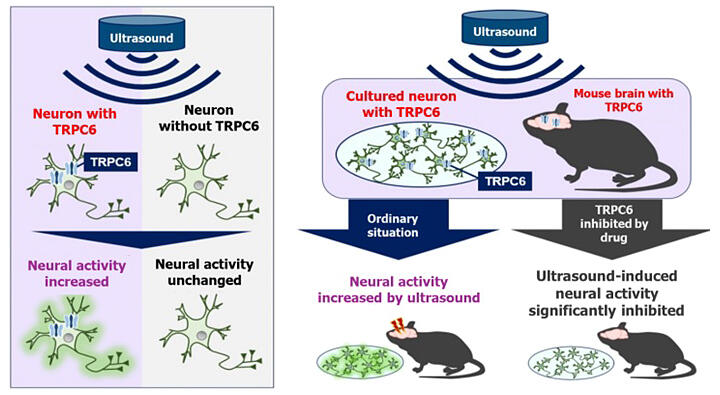A research group led by Researcher Yumi Matsushita and Project Manager Masafumi Shimojo at the Advanced Neuroimaging Center, Institute for Quantum Medical Science, National Institutes for Quantum Science and Technology (QST), in collaboration with Professor Yuichi Takeuchi of the Department of Pharmacy, Faculty of Pharmacy at Kindai University, and their collaborators, has announced their findings revealing that "TRPC6," a mechanosensitive sensor molecule, is essential for the increase in brain neural activity induced by ultrasound stimulation. This was discovered by constructing a unique experimental system that can measure cellular activity in real time while simultaneously stimulating it with ultrasound. The findings are expected to find application in the ultrasound-based treatment of neurodegenerative diseases and depression. The results were published in the December 4 issue of PNAS, the Proceedings of the National Academy of Sciences of the United States of America.

Provided by QST
Ultrasound waves have wavelengths in a high frequency range of ≥20 kilohertz, which are inaudible to human ears, and are widely used in medical care for diagnostic imaging, such as ultrasonic echography. Treatment methods to modulate neuronal activity in the brain using electric currents and magnetic field to stimulate the brains of patients with neurological diseases, such as Parkinson's disease, or psychiatric disorders, such as depression, have been put to practical use. Recent studies have reported that the neuronal activity can also be modulated by ultrasound irradiation of nerves in the brain or limbs. However, the mechanism remained unknown.
To elucidate this mechanism, the research group focused on sensor molecules on the cell surface. They constructed a unique system suitable for microscopic observation of cell activity induced by ultrasound irradiation to investigate the effects of ultrasound waves on neuronal activity.
Using this system, they observed mouse neurons while irradiating them with ultrasound (1 MHz) and succeeded in observing a phenomenon in which the activity level increased immediately after irradiation. Among the effects of ultrasound on living organisms, they focused on the mechanical effects of pressure and vibration caused by exposing the cells to ultrasound and searched for candidate mediators.
Through experiments in which numerous sensor molecules were blocked individually, they discovered "TRPC6," which is responsive to ultrasound. This sensor molecule was known to be expressed in organs prone to receiving pressure, such as the heart and lungs, and also in neurons in the brain; however, its function in the brain was unknown.
Neurons generated from TRPC6-deficient mice showed no increases in the neuronal activity in response to ultrasound irradiation. When this function was restored, the ultrasound-induced increase in neuronal activity was restored. Furthermore, the experiment was verified in the brains of living mice. When ultrasound was applied from outside the skull, an increase in neural activity was observed in normal mice. However, when a specific TRPC6 inhibitor was administered, the increase in neural activity was prevented.
Matsushita said, "Treatment of brain diseases using ultrasound has just begun. If the results of this study can be used to optimize frequency, stimulation intensity, and other parameters for more efficient modulation of brain activity, medical applications of ultrasound will become safer and more precise than ever before. TRPC6 has been linked to dementia, Alzheimer's disease, and depression, and we expect that ultrasound stimulation of TRPC6 combined with control of TRPC6 using pharmacological and other methods could be effective for the treatment of these diseases. In neurodegenerative diseases and psychiatric disorders, neuronal activity and the activity of neurons and glial cells differ from that in the normal brain. Moving forward, I hope to study this therapeutic approach for potential application as a new tool to recover the activity of these cells to normal levels, with the goal of clinical applications."
Journal Information
Publication: PNAS
Title: TRPC6 is a mechanosensitive channel essential for ultrasound neuromodulation in the mammalian brain
DOI: 10.1073/pnas.2404877121
This article has been translated by JST with permission from The Science News Ltd. (https://sci-news.co.jp/). Unauthorized reproduction of the article and photographs is prohibited.




